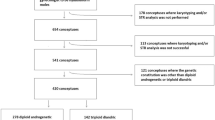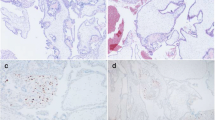Summary
The origin of 29 polyploid conceptuses with villous cystic swelling was examined. One tetraploid specimen showed one maternal and three paternal contributions to the genome. Informative cytogenetic markers in 24 triploids were consistent with fertilization by dispermy. Analysis of cytogenetic markers indicated that polyspermy may account for essentially all polyploid conceptions with an excess of paternal to maternal chromosome complements. The origin of the genome was primarily demonstrated by the study of cytogenetic markers, while HLA determination and enzyme analysis were less informative.
Similar content being viewed by others
References
Couillin P, Hors J, Boué A (1978) Identification of the origin of triploidy by HLA markers. Hum Genet 41:35–44
De Capoa A, Marlekaj P, Baldini A, Rocchi M, Archidiacono N (1985) Cytologic demonstration of differential activity of rRNA gene clusters in different human tissues. Hum Genet 69:212–217
Dissing J, Eriksen B (1984) Human red cell esterase D polymorphism in Denmark, its use in paternity cases and the description of a new phenotype. Hum Hered 34:48–155
Dissing J, Svensmark O (1976) Human red cell acid phosphatase: quantitative evidence of a silent gene Po, and a Danish population study. Hum Hered 26:43–58
Eriksen B (1979) Human red cell glyoxalase I polymorphism in Denmark and its application to paternity cases. Hum Hered 29:265–271
Hansen HE, Vejerslev LO (1985) Hydatidiform mole and HLA. Methods for HLA-A, B, C determination. J Immunol Methods 83:343–352
Jacobs PA, Morton NE (1977) Origin of human trisomics and polyploids. Hum Hered 27:59–72
Jacobs PA, Szulman AE, Funkhouser J, Matsuura JS, Wilson CC (1982) Human triploidy: relationship between parental origin of the additional haploid complement and development of partial hydatidiform mole. Ann Hum Genet 46:223–231
Kajii T, Niikawa N (1977) Origin of triploidy and tetraploidy in man: 11 cases with chromosome markers. Cytogenet Cell Genet 18: 109–125
Lawler SD, Fisher RA, Pickthall VJ, Povey S, Wyn Evans M (1982) Genetic studies on hydatidiform moles. I. The origin of partial moles. Cancer Genet Cytogenet 5:309–320
Martin RH, Balkan W, Burns K, Rademaker AW, Lin CC, Rudd NL (1983) The chromosome constitution of 1000 human spermatozoa. Hum Genet 63:305–309
Meulenbroek GHM, Geraedts JPM (1982) Parental origin of chromosome abnormalities in spontaneous abortions. Hum Genet 62: 129–133
Parazzini F, La Vecchia C, Pampallona S (1986) Parental age and risk of complete and partial hydatidiform mole. Br J Obstet Gynaecol 93:582–585
Pearson G, Mann JD, Bensen J, Bull RW (1979) Inversion duplication of chromosome 6 with trisomic codominant expression of HLA antigens. Am J Hum Genet 31:29–34
Procter SE, Gray ES, Watt JL (1984) Triploidy, partial mole and dispermy. An investigation of 12 cases. Clin Genet 26:46–51
Sand PK, Lurain JR, Brewer JI (1984) Repeat gestational trophoblastic disease. Obstet Gynecol 63:140–144
Sheppard DM, Fisher RA, Lawler SD, Povey S (1982) Tetraploid conceptus with three paternal contributions. Hum Genet 62:371–374
Surti U, Szulman AE, Wagner K, Leppert M, O'Brian SJ (1986) Tetraploid partial hydatidiform moles: two cases with a triple paternal contribution and a 92,XXXY karyotype. Hum Genet 72: 15–21
Szulman AE, Philippe E, Boué JG, Boué A (1981) Human triploidy: association with partial hydatidiform moles and nonmolar conceptuses. Hum Pathol 12:1016–1021
Tommerup N, Vejerslev LO (1985) Identification of triploidy by DA/DAPI staining of trophoblastic interphase nuclei. Placenta 6:363–367
Uchida IA, Freeman VCP (1985) Triploidy and chromosomes. Am J Obstet Gynecol 151:65–69
Vassilakos P, Riotton G, Kajii T (1977) Hydatidiform mole: two entities. A morphologic and cytogenetic study with some clinical considerations. Am J Obstet Gynecol 126:167–170
Vejerslev LO, Mogensen B, Olsen S (1984) Hydatidiform mole in a Danish material Morphology and cytogenetics. A preliminary communication. Acta Radiol [Oncol] 23:97–102
Vejerslev LO, Tommerup N, Hallberg A (1986a) Hydatidiform moles: methods for culture and cytogenetic analyses. Cancer Genet Cytogenet 22:19–27
Vejerslev LO, Kristoffersen K, Lopez H (1986b) Dispermy as the origin of partial moles as well as a nonmolar conception. Genecol Obstet Invest 21:26–31
Vejerslev LO, Dissing J, Hansen HE, Poulsen H (1987) Hydatidiform mole. Genetic markers in diploid abortuses with macroscopic villous enlargement. Cancer Genet Cytogenet (in press)
Weidinger S, Schwarzfischer F (1980) PGM1 subtypes determined by agarose gel isoelectrofocusing. Z Rechtsmed 84:221–224
Womack C, Elston CW (1985) Hydatidiform mole in Nottingham: a 12-year retrospective epidemiological and morphological study. Placenta 6:93–106
Author information
Authors and Affiliations
Rights and permissions
About this article
Cite this article
Vejerslev, L.O., Dissing, J., Hansen, H.E. et al. Hydatidiform mole: genetic origin in polyploid conceptuses. Hum Genet 76, 11–19 (1987). https://doi.org/10.1007/BF00283043
Received:
Revised:
Issue Date:
DOI: https://doi.org/10.1007/BF00283043




